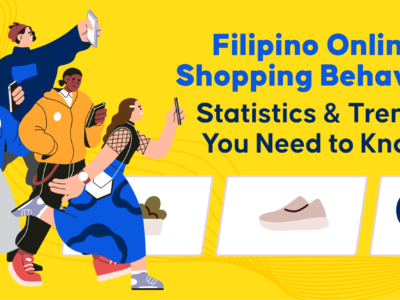Navigating the Gen Z Marketing Landscape? Skip the guesswork and consult with our marketing experts in the Philippines. Learn more about our content marketing services.
Younger buyers are slowly taking over the market as they attain greater purchasing power. Paying close attention to their purchasing preferences and habits is crucial to staying ahead of the curve and leveraging their characteristics to build your brand.
That said, the strategies for attracting members of Generation Z in the Philippines may significantly differ from preceding cohorts. As the most culturally diverse age group, they generally expect brands to value social responsibility—a trend they share with millennials. In contrast, companies didn’t have to concern themselves much with these principles when handling Gen X buyers and baby boomers.
Given these changes in the marketing landscape, it’s understandably challenging to attract younger generations. So, improve your advertising operations by studying Gen Z Filipino preferences and behaviors. With that in mind, let’s tackle the practice of marketing to Gen Z in the Philippines to help you learn more about the Filipino youth and take advantage of this opportunity to grow your brand.
Understanding Gen Z in the Philippines
Many Gen Zs witnessed their parents suffer from significant financial setbacks during the Great Recession. Coupled with current technological advancements and sociopolitical progress, you’d be surprised by how different marketing to this generation is from preceding ones. Here are some primary considerations for attracting Gen Zs to your business.
1. Diversity and sustainability

Source: Deloitte 2023 Gen Z and Millenial Survey
Gen Z consumers emphasize the value of social responsibility; A 2022 survey found that 80% of Filipino youth are trying to minimize their environmental impact. Meanwhile, regarding diversity and inclusivity, only 33% are satisfied with their organization’s efforts, indicating a desire for improvements.
2. Mental health
Gen Z Filipinos are more prone to mental health issues. A study from AXA found that 35% have experienced depression, while 16% suffered from anxiety. These figures are especially alarming since they’re higher than the global average, which sits at 27% and 12%, respectively. These issues stem from uncertainty (69%), lack of work-life balance (49%), and drastic changes at work (47%).
3. Tech and automation

Source: Tara Winstead via Pexels
Gen Zs are no strangers to emerging technologies like artificial intelligence (AI) and automation. Dell reports that 80% of this cohort want to work with cutting-edge tech in their careers, with 51% expecting humans and machines to work together.
4. Online selling
Online marketplaces are increasingly popular among young Filipinos, with most using these platforms as side hustles. In fact, 32% of Gen Zs in the Philippines are selling products or services online, making these platforms a potential goldmine for marketers targeting younger demographics.
5. Buying habits
Many Filipino Gen Zs leverage online marketplaces to buy as well. A 2022 research paper revealed that 91.03% of this demographic primarily use the Internet to look up products, with most of them buying from Shopee (83.67%) than its competitor, Lazada.
At the same time, product brand, price, quality, and advertisement are primary driving factors in their purchasing decisions (53.3%), more than reviews, delivery times, and convenience.
6. Video content consumption
Online video content, like live streams and vlogs, is growing in popularity among Filipino youth as an avenue to express their creativity and entrepreneurship. A staggering 74% of Gen Zs consume video content for entertainment, thanks to the accessibility of mobile devices and home Wi-Fi setups.

Effective Marketing Strategies for Attracting Gen Z in the Philippines
Now that you understand a few key characteristics of the Filipino youth, you can start to implement the following tried-and-tested strategies to grow your business.
1. Utilize social media

Source: Rawpixel.com
Social media has become instrumental in today’s business landscape, primarily thanks to younger generations. Statista reports that 81% of Filipino Gen Zs use social networks more than any other platform, making Facebook, Twitter, and others a vital channel for reaching this demographic.
So, place social media marketing on top of your advertising strategy. Take advantage of pay-per-click (PPC) ads, sponsored products, influencer marketing, and other tactics to drive high-quality leads, especially as older Gen Zs enter the workforce and attain greater purchasing power.
Also Read: The Cost of Social Media Advertising
2. Create engaging and interactive content
Interactive content is proven vital in audience engagement. It encompasses quizzes, polls, and augmented reality (AR), encouraging users and visitors to participate actively and interact with your brand rather than passively consuming information. In turn, you can establish lasting emotional connections that lead to higher conversions and better customer retention metrics.
3. Tap into user-generated content
Another way to boost audience engagement is to reduce traditional content. Instead, increase the production of user-generated content (UGC), which are those coming from buyers, advocates, and affiliates. It includes product reviews, testimonials, and social media posts offering insight into your company and products from other buyers’ perspectives.
Ultimately, leveraging UGCs lets you establish a reputation as a trust signal. Take pictures, for example—80% of consumers prefer product photos from actual buyers over company or stock pictures. So, allowing buyers to post images of their purchases via product reviews strengthens your reputation as a trustworthy brand.
4. Establish a brand advocacy
Again, Gen Zs want socially responsible brands. For instance, younger generations comprise 92% of Filipino shoppers who prefer natural, eco-friendly products. There’s also a rising number of vegan or cruelty-free choices in the Philippines seeking to address growing animal welfare concerns.
Given these trends, going green and making other brand adjustments aligning with their values help your products and marketing messages resonate with them better.
Challenges and Opportunities in Marketing to Gen Z in the Philippines
Tapping into the Gen Z market presents numerous growth opportunities for your enterprise, but that’s not to say that it doesn’t have potential liabilities. Consider the following challenges and opportunities to help mitigate potential risks down the line.
Challenges
1. Short attention spans
Gen Zs grew up in the digital age, where information is constantly available at rapid fire. So, capturing and maintaining their attention, especially with long-form content, could be challenging.
2. Ad-avoidance
The younger generation’s technical know-how makes them more knowledgeable about ad blockers for intrusive promotions. You’ll have to deliver creative, non-traditional ad campaigns to avoid triggering these systems.
3. Authenticity and transparency
Gen Zs are more socially aware than previous generations, so they’re more critical of brands that are pandering or displaying inauthentic marketing efforts. A considerable 23% of Gen Z emphasize the importance of authenticity and that a lack of transparency reduces their opinion of brands.
4. Mobile-first mindset

Source: Statista 2023
Most Filipinos own a smartphone, and this is met with an increasing number of smartphone users until 2028. So, non-mobile-friendly marketing campaigns might find it difficult, if not impossible, to reach and appeal to a mobile-first population, let alone the generation that grew up with these devices.
5. No Access to Credit
Gen Zs have limited financial resources to make purchases. Such purchasing power is constrained without access to credit, making it difficult for marketers to promote higher-priced or aspirational products.
Opportunities
1. Social media

Source: DataReportal and INSG.Co
Filipino Gen Zs are highly active on social media. This generational characteristic is an opportunity to leverage social media influencers and create compelling content that resonates with their interests on these platforms.
2. Influencer marketing
Partnering with influencers in social media and other marketing channels lets you tap into their audience, especially with 90% of the Asian youth, including Filipinos, following at least one influencer. Additionally, 70% of Filipino online consumers have purchased a product from an influencer recommendation.
These celebrities’ authoritative status can make your brand seem more trustworthy and competitive, potentially increasing your leads.
3. User-generated content
Peer recommendations and authentic experiences strengthen your products’ reputation. Integrate them as customer reviews, testimonials, social media mentions, and other UGC to build trust and credibility among Gen Z buyers.
4. Personalization
Personalization is a critical aspect of marketing to any generation, but even more so to younger ones. Surprisingly, 41% of Gen Z consumers are willing to surrender their data if they receive personalized experiences in return, emphasizing the importance of tailor-made campaigns.
5. Augmented and virtual reality (VR)
AR and VR technologies are taking the world by storm, and they’re another opportunity to market to the tech-savvy youth. These platforms allow you to provide interactive and immersive experiences beyond traditional advertising—features that Gen Zs increasingly gravitate to.
Filipino Gen Z Marketing: Practical Applications of Effective Marketing Strategies
Integrating the strategies we’ve discussed into practical campaigns can help you reach and engage this increasingly lucrative audience.
1. Case studies
Strengthen your brand reputation by creating case studies exhibiting sales and retention wins. Showcasing real-life examples of how your product or service has helped solve problems demonstrates your brand’s credibility, mainly if these success stories include verifiable testimonies from actual buyers.
More than that, case studies are an opportunity to demonstrate your authenticity and capture readers’ attention via visual content. Be sure to distribute these materials via social media, email newsletters, and other marketing channels popular among Gen Zs to maximize their reach.
2. Strategy analysis
Comprehensively analyzing marketing campaigns and strategies helps you utilize Filipino Gen Zs’ preferences, behaviors, and trends to understand your buyers better.
You could also directly seek feedback through surveys and focus groups for firsthand information about your strategies’ effectiveness. This tactic directly involves prospects in your organization’s decision-making process, which may make them more receptive to your marketing efforts.
3. Influencer partnerships
Collaborate with famous influencers and content creators on popular marketing channels like Instagram and YouTube to build your following. This powerful strategy lets you partner with celebrities who align with your brand and have a genuine connection with their audience. You could then leverage their influence and credibility to reach and attract Gen Zs.
Start by performing comprehensive market research to discover popular vloggers, game streamers, and musicians who are prevalent among your target audience and align with your objectives. Then, propose a mutually beneficial partnership that brings value to both brands.
4. Experiential marketing events
As mentioned, Gen Zs prefer immersive marketing experiences, so organizing events and activities allowing them to interact with your brand firsthand may be the key to creating a lasting impression.
You could set up pop-up stores, workshops, live performances, or creative installations to provide memorable experiences to your audience. These efforts enable you to forge strong emotional connections and generate positive word-of-mouth buzz to build brand awareness.
Marketing to Filipino Gen Zs may feel like treading unfamiliar territory, especially if you’re a foreign brand. However, it isn’t different from dealing with other age cohorts or locations—all it takes is understanding your target market. So, study their unique characteristics, preferences, and behaviors to build lasting relationships with this demographic and drive business success.
That said, you won’t have to deal with the task alone. Skip the guesswork and consult with our marketing experts at Spiralytics, a leading content marketing agency in the Philippines, to start engaging the youth in this rapidly evolving marketing landscape.
Contact us today and get started on your long-term success!
Let’s answer some frequently asked questions about marketing to Filipino Gen Zs to help you develop better campaigns and strategies.
1. How can I effectively reach Gen Z in the Philippines through social media?You can effectively reach Gen Z in the Philippines through social media by focusing on their most-used platforms. Meltwater reports that Facebook is the most popular social media platform in the Philippines, with Facebook Messenger, Instagram, TikTok, and Twitter following it. Use these platforms to create and spread visually appealing and engaging content for Filipino youth.
2. What are the key factors influencing the purchasing decisions of Gen Z Filipinos?
The key factors influencing the purchasing decisions of Gen Z Filipinos include authenticity, social responsibility, personalization, transparency, and interactivity. They also prefer brands that align with their values, so make necessary adjustments to resonate with your younger audience better.
3. Is traditional advertising still relevant for Gen Z in the Philippines?
Traditional advertising is still relevant for Gen Z in the Philippines, but they prefer newer, less intrusive strategies, such as native advertising and interactive marketing. They are becoming more likely to respond to authentic and personalized experiences rather than traditional, interruptive ads. However, you could still leverage campaigns combining traditional and newer tactics to maximize engagement.





